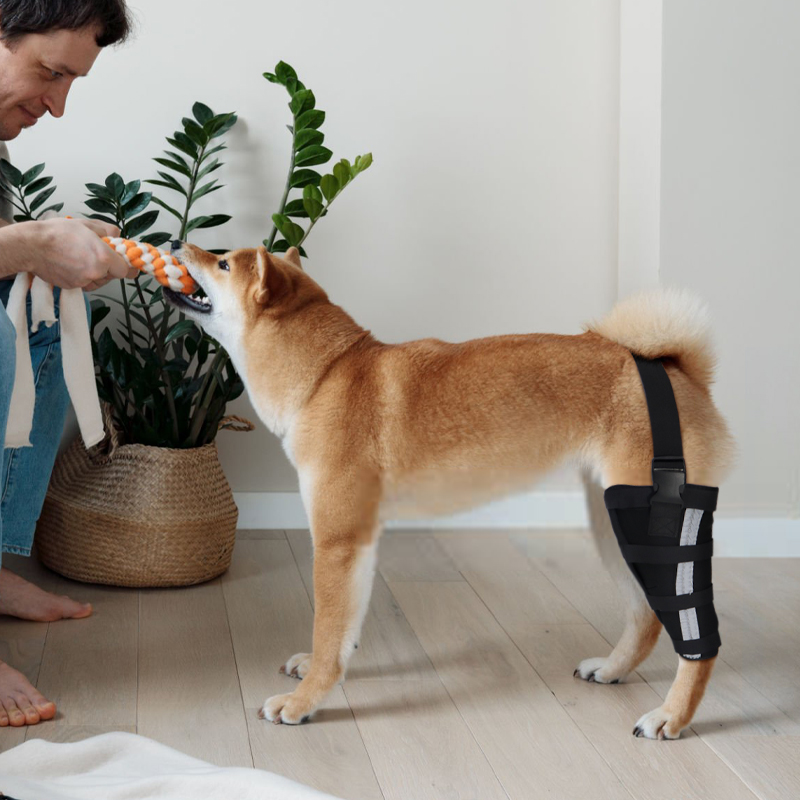Knee dysplasia, also known as patellar luxation, is a common condition in dogs, especially in small breeds. This condition occurs when the kneecap (patella) moves out of its normal position, causing discomfort and potential mobility issues. Recognizing the symptoms early is crucial to ensuring your dog gets the care it needs, possibly including the use of a small dog leg brace or other supportive devices. Below are some key symptoms to watch out for.
1. Limping or Lameness
One of the first signs of knee dysplasia in dogs is limping or lameness. You may notice your dog favoring one leg over the other, especially after exercise or during periods of activity. This could indicate that the kneecap is slipping out of place, causing your dog to experience pain or discomfort. In such cases, using a dog knee brace can help stabilize the joint and reduce the strain on the affected leg.
2. Skipping or Hopping Gait
A telltale symptom of knee dysplasia is a skipping or hopping gait. This occurs when the kneecap temporarily moves out of position and then snaps back into place. You might see your dog lift its leg for a few steps before resuming normal walking. A knee brace for dogs ACL can provide the support needed to prevent this kind of irregular gait, especially if the condition is related to an ACL injury.
3. Stiffness or Difficulty Rising
Dogs with knee dysplasia often exhibit stiffness, particularly after rest or in the morning. You may notice that your dog has difficulty rising from a lying position or seems reluctant to move. If your dog has been diagnosed with an ACL injury, a dog knee brace for ACL injury can be a critical part of their treatment plan, helping to alleviate stiffness and support the knee during recovery.
4. Pain or Sensitivity
Dogs suffering from knee dysplasia may show signs of pain or sensitivity around the knee joint. They may yelp, whine, or pull away when the area is touched. In severe cases, the condition can lead to chronic pain, making it essential to consider options like a dog knee brace for torn ACL to provide relief and prevent further damage.
5. Reduced Activity Level
As the condition progresses, your dog may become less active, avoiding activities that were once enjoyable, such as running, jumping, or playing. This reduction in activity is often a way for your dog to manage its pain. To help maintain your dog’s mobility and quality of life, using a small dog leg brace or other supportive devices can be incredibly beneficial.
6. Muscle Atrophy
Over time, knee dysplasia can lead to muscle atrophy in the affected leg. This happens because the dog may avoid using the leg, leading to a decrease in muscle mass. A knee brace for dogs ACL can help distribute weight more evenly across the legs, preventing muscle atrophy and aiding in rehabilitation.
7. Popping or Clicking Sound
In some cases, you might hear a popping or clicking sound when your dog moves its leg. This sound is often caused by the kneecap slipping in and out of place. While not always present, it can be a clear sign of knee dysplasia. A dog knee brace for ACL injury can help stabilize the joint and reduce these sounds, making your dog more comfortable.
Conclusion
Knee dysplasia is a condition that requires attention, especially as it can significantly impact your dog’s mobility and quality of life. Recognizing the symptoms early and taking proactive steps, such as using a dog knee brace or a dog knee brace for torn ACL, can help manage the condition and prevent it from worsening. If you notice any of these symptoms in your dog, consult with your veterinarian to discuss the best treatment options.
By staying vigilant and providing the necessary care, you can help ensure that your furry friend stays active and healthy for years to come.



0 Comments